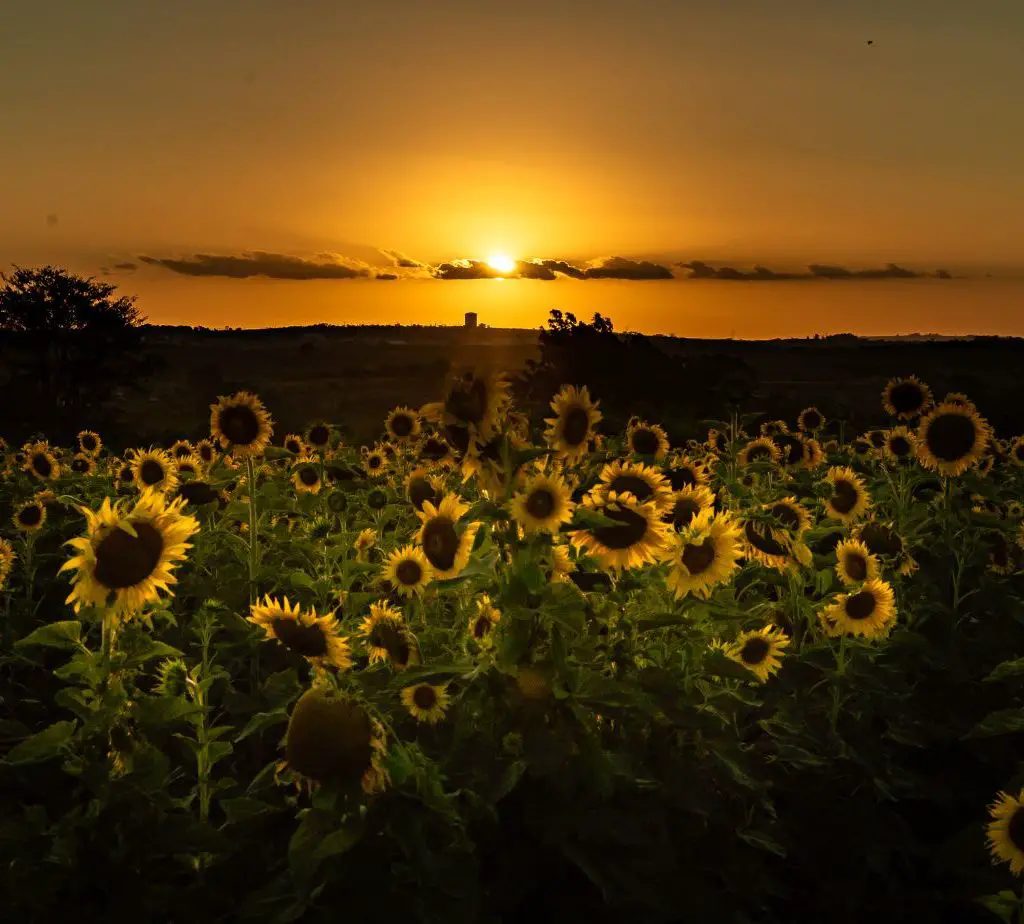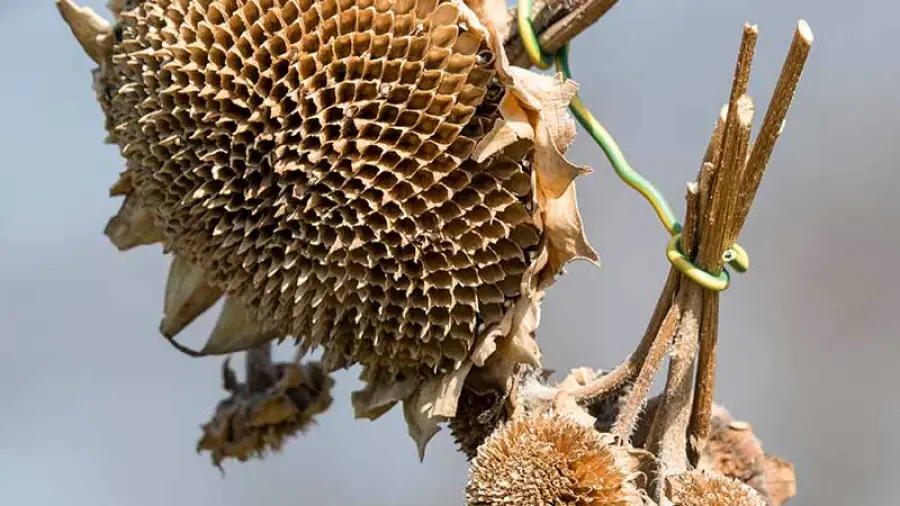Remove dead sunflower heads by cutting them off and harvesting the seeds if desired. Compost the remaining plant material to enrich garden soil.
Sunflowers, with their vibrant presence, are a staple of summer gardens, but as the season changes, these once bright and towering plants fade, leaving gardeners pondering on what to do next. Dead sunflower heads, heavy with seeds, bend towards the ground, signaling the end of their lifecycle, yet offering new beginnings in various forms.

Harvesting the seeds can provide snacks for humans and birds, while composting the spent heads contributes to a nutrient-rich additive for future plantings. Embracing the cycle of growth, decline, and rejuvenation, gardeners can find purpose for every stage of their sunflower’s journey, ensuring nothing goes to waste and the garden thrives year after year.
Varieties Of Sunflowers And Lifespans
Sunflowers brighten gardens with their vibrant petals and towering presence. But what happens when they wilt? It’s important to understand the diverse types of sunflowers and their lifespans before deciding on the best use for those spent blooms. Each variety not only differs in color and size but also in how long they grace our gardens with their beauty.
Life Cycle Of A Sunflower
The journey of a sunflower from seed to bloom is fascinating. A sunflower typically goes through four main stages of growth: seedling, vegetative, budding, and flowering. After flowering, the head turns brown, indicating the end of its life cycle. Seeds mature within the heads and become the start of new life.
Types Of Sunflowers And Their Characteristics
Sunflowers come in a variety of types, each boasting unique features. Let’s explore some common varieties:
| Type | Description | Lifespan |
|---|---|---|
| Helianthus annuus | Also known as the common sunflower, notable for its large, yellow blooms. | 80-120 days |
| Autumn Beauty | Features a mix of warm colors, perfect for a fall aesthetic. | 85-110 days |
| Mammoth | Famous for its gigantic size, perfect for a show-stopping garden display. | 90-100 days |
| Dwarf Sunspot | Compact and ideal for smaller spaces with shorter growing periods. | 65-75 days |
Signs That Your Sunflower Has Reached Its End
Gardeners often find joy in the bright blooms of sunflowers. Yet, these bold flowers do not last forever. Knowing when a sunflower has passed its prime is key to managing your garden’s life cycle.
Visual Cues Of A Dying Sunflower
As the season changes, a sunflower’s life cycle nears its end.
- Leaves turn brown and lose their vibrant green hue.
- Petals wilt, dropping from the head to signal a closing chapter.
- The once sturdy stem weakens and may begin to bend or break.
- Seeds in the head mature and the back of the head turns yellow to brown.
These visual signs guide gardeners on the path to harvest or remove the spent plant.
How To Tell If The Sunflower Head Is Dead
To confirm a sunflower head’s death, a close inspection is necessary.
- Tug gently on a few seeds. If they pop out easily, the head has died.
- Examine the face of the sunflower. A lack of petals and a brittle, dry feel indicate demise.
- Look for mold or decay, which flourish on deceased plant matter.
- Seed-eating birds often move on, indicating the seeds are no longer viable.
Once these signs become clear, it’s time to consider the next steps for these sunflower heads.
The content does not provide explicit next steps as per the user requirements to avoid going beyond the scope of the requested section.
Harvesting Sunflower Seeds
As summer winds down, those towering beacons of vibrant color, sunflowers, begin to droop. It’s not the end, but a chance to harvest. Sunflower heads, heavy with seeds, offer a cornucopia of possibilities. Gardeners rejoice in harvesting sunflower seeds, either to replant, to feed birds, or to snack on. Understanding the proper techniques for collecting seeds and knowing how to store them will make the most of your sunflower bounty.
Proper Technique For Collecting Seeds
- Wait until the back of the sunflower head turns brown.
- Cut the head off along with a few inches of stem.
- Rub your hand over the seeds to loosen them.
- Shake out the seeds over a container to catch them.
- Remove any remaining petals or debris.
Storage Tips For Sunflower Seeds
| Step | Tip |
|---|---|
| 1 | Ensure seeds are completely dry before storing. |
| 2 | Use airtight containers or sealable plastic bags. |
| 3 | Label with the date and type of sunflower seeds. |
| 4 | Store in a cool, dry place; a fridge is ideal. |
| 5 | Check periodically for signs of moisture or mold. |
Creative Uses For Dead Sunflower Heads
Don’t toss out those dead sunflower heads just yet! They’re chock-full of potential for creativity and decoration. With their distinctive shapes and seeds, these remnants of summer can be transformed into beautiful works of art or charming home accents. Let’s dive into the world of crafting and decorating with these natural treasures.
Crafting With Sunflower Heads
Sunflower heads make for perfect crafting materials. Below are some creative ideas:
- Bird Feeder: Remove the seeds and coat the head with peanut butter. Roll it in birdseed and hang it up.
- Painting Canvas: Use the bumpy texture of the head for a unique painting surface.
- Seed Mosaic: Create designs by gluing seeds onto cardstock or wood.
Sunflower Heads In Home Decor
Integrated into home decor, sunflower heads offer a rustic charm.
| Decor Item | Ideas |
|---|---|
| Wreaths: | Attach to a wreath form for a seasonal door decoration. |
| Centerpieces: | Combine with candles and pinecones on a tray. |
| Wall Art: | Mount dried heads in shadow boxes or frames. |
Turning Waste Into Garden Gold
Turning Waste into Garden Gold should not be an overlooked art. Those once vibrant sunflower heads, drooping with the passing of summer, can spark new life into your garden. The towering beauties of your garden, even in their fading form, have much to offer. Their cycle in your garden need not end with the close of the season. Learn to transform these natural treasures into valuable resources for next year’s growth.
Composting Sunflower Heads
Nutrient-rich compost is black gold for every garden, and sunflower heads are excellent additions to your compost pile. Follow these simple steps:
- Chop them up – Smaller pieces break down quicker.
- Balance – Mix with green and brown compost materials.
- Turn the pile – This helps for even decomposition.
Be patient. Over time, the sunflower heads will decompose and enrich your compost with potassium and magnesium, essential for plant growth.
Using Sunflower Stalks For Support In Gardens
The sturdy stalks of sunflowers can serve a new purpose. Do not discard these natural poles. Here’s how to use them:
- Cut them down – Trim to desired lengths after the heads are removed.
- Position strategically – Place near plants that require support.
- Secure plants – Use garden ties to attach plants to the stalks.
These stalks not only add structural integrity to your garden but also contribute to its natural aesthetic. Their rough texture is also great for supporting climbing plants.
Supporting Wildlife With Sunflower Remnants
As sunflower blooms fade, life springs from their seeds and husks. Flower heads, though no longer vibrant, serve as resources. Dead sunflower heads provide food and shelter for various wildlife throughout the seasons. This support is crucial for ecosystem equilibrium. Artful reuse of sunflower remnants benefits your garden’s wildlife. Consider these humane, resourceful actions to keep nature thriving.
Feeding Birds With Sunflower Seeds
Sunflower seeds are nutritious treats for birds. When flowers wilt, these seeds become feasts. Strip seeds from their heads. Hang them in mesh bags or scatter them on a table. This attracts finches, cardinals, and more. Watch their merriment from your window.
Providing Shelter For Insects
Insects find solace in dry sunflower stalks and heads. Bees and other bugs nest in the hollow stems. Even birds repurpose them for building material. Leave a few heads and stalks in your garden. This simple act enriches local biodiversity.
Here’s how you can set up a sunflower insect hotel:
- Collect several dried stalks.
- Bundle them together.
- Tie the bundle securely.
- Position it horizontally off the ground.
Watch as these natural havens become buzzing with life!
(Check this out for more suggestions : https://www.growgardener.com/what-to-do-with-dead-sunflower-heads/)
Frequently Asked Questions Of What To Do With Dead Sunflower Heads
Should You Cut Off Dead Sunflower Heads?
Yes, you should cut off dead sunflower heads to encourage new growth and maintain plant health, ideally after they fade or wilt.
What To Do With Sunflower After It Dies?
After a sunflower dies, cut the stem and remove any leaves. Hang the head upside down in a dry, ventilated space to extract seeds or leave it in the garden to feed birds. Compost the remaining plant parts to enrich the soil.
What Do I Do With Sunflower Heads?
Harvest sunflower heads after petals fall and hang them to dry. Collect seeds for snacking or planting. Compost remaining plant material to enrich your garden soil.
Do Sunflowers Grow Back After Cutting?
Sunflowers do not regrow after the main stem is cut. However, if smaller side shoots are left intact, they may produce additional blooms.
Conclusion
Repurposing dead sunflower heads enriches your garden and supports local wildlife. These leftovers transform into bird feed, contribute to compost, or become crafts. Embrace nature’s cycle by giving sunflower remnants a new lease on life. Let your creativity and sustainability go hand in hand for a greener tomorrow.
(To know more about Sunflower : https://bonsainurserybd.com/sunflower-splendor/)
